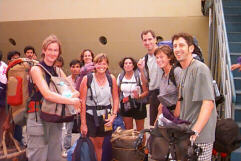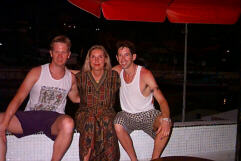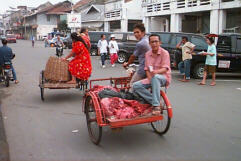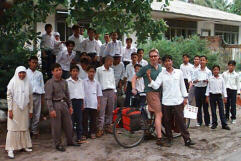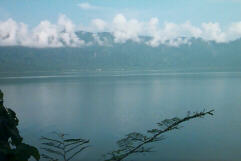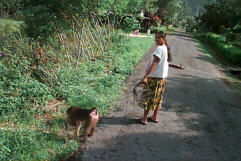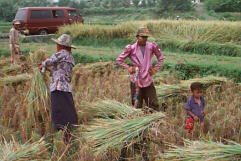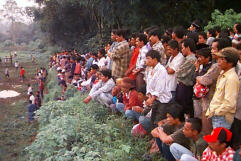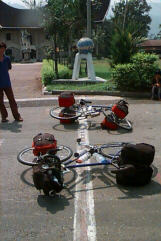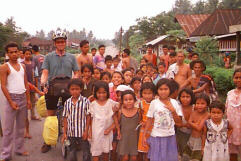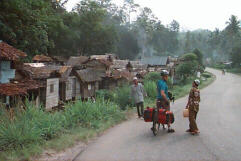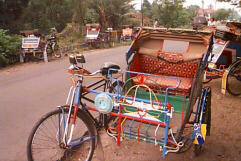| 1997 CALIFORNIA TO FLORIDA CA to AZ AZ to NM TX 1 TX 2 TX & LA LA, MS, & FL FL WESTERN EUROPE Spain & French Pyrenees France –Bordeaux & SW Coast 1 France –Bordeaux & SW Coast 2 France – Notre Dame des Cyclistes England Belgium & Holland Germany NORTHERN EUROPE Denmark Sweden Finland Estonia, Latvia, Lithuania EASTERN & SO. EUROPE Poland Slovakia and Hungary Croatia, Slovenia & Bosnia-Herzegevina MIDDLE EAST Turkey Cyprus Israel & the West Bank Zealot City Jerusalem Syndrome Jordan Egypt 1998 OTHER VOYAGES |
TRIPLOGUE Indonesia IV: Western Sumatra
16-18 April, Jakarta to Padang (a) Having taken ferries between other islands in Indonesia, neither Fred nor I were exactly expecting our twenty-eight hour voyage to Sumatra to be a luxury cruise. But the Pelni Lines "Lembalu" proved to be a surprisingly glamorous vessel, built in Germany and put into service only six months ago. The wooden decks and fresh white paint fairly gleamed; our cabin was roomy and comfortable; even the food was decent. Only several clues let us know that we were still in Indonesia –like the fact that what was meant to be the swimming pool was now a mosque, or that the cinema was showing "Titanic" (on the whole, Indonesians seem incapable of grasping even the most basic of ironies). A handful of other bulehs was on the boat, making us realize that after a month off the beaten track, we were once again following the tourist trail. Newlyweds Matt and Jennifer from New Hampshire were the only others in first class, while Florence from France and her friend Raewyn from New Zealand were traveling in second. Further below, Ami from Israel and Wilhelmina from Holland shared the more basic amenities of third class; and then there was a brave soul with an Irish accent who only emerged once from "Ekonomi" class to beg the barman in our dining room to sell him some breakfast. Fred and I referred to the lower decks of the ship, which housed the vast majority of domestic travelers, "kampung class"; all that was missing from the village-like atmosphere were farm animals. The twenty-eight hours at sea passed far too quickly. Most of the time was spent reading, sleeping and chatting with our new friends, all of whom were following a well-worn trail through West and North Sumatra –the same trail that we’d be following at a considerably slower pace. None of the other young travelers, for example, planned to spend any time in Padang, opting to board a bus straight for Bukittinggi when we docked. Fred and I bade them all farewell and headed in towards town, which people told us was about ten kilometers away. As soon as we started pedaling the brewing storm clouds dumped their wet load. We sought refuge under the eave of a small grocery store for awhile before deciding to brave the drops again. When the rain turned into a downpour a Kijang sidled up to us and offered us a ride. "For free!" insisted the friendly young driver, who explained that he’d just gone down to the dock to change a dirty twenty-dollar bill for a clean one. He said he had many American friends who worked on the numerous ships that passed through the port. Dumping us off under the eaves of the Batang Arau Hotel, our savior declined our offer to buy him a beer and headed off into the wet twilight. The Batang Arau used to be a Dutch bank, and has more ambiance than you can shake a stick at. An odd woman with her teeth filed to points (from Nias island, I learned later) showed me a choice of huge rooms overlooking a funky river port yet was unable to tell me the price. "You’ll have to ask Norma about that," she explained. As if on cue, Norma appeared out of nowhere, a radiantly gorgeous German woman who has lived in Padang for three years. She could hardly contain her enthusiasm for our cycling project and insisted we join a birthday party she was throwing on the upper verandah overlooking the river. Declining the over-gracious invitation wasn’t an option. "You must join us," she urged in perfect, sexily accented English, "there’ll be Scottish dancing and there aren’t enough men." Thrusting glasses of cognac into our hands, she gushed about all Padang had to offer, and how the nearby Mentawai islands were the most exotic destination in Indonesia. "If you have the time, you really have to go there." So convincing was her pitch that it was only a matter of minutes before we had changed our travel plans. Why not check out Mentawai? Photos of tattooed natives wearing only loincloths and feathers made it look a lot more appealing than Malaysia. And after a quick visit there we could continue northwards to Lake Toba and North Sumatra. Neither of us was anxious to get out of Indonesia, and it’s not every day that the country throws an 80%-off sale. The party was a hoot, presenting us an interesting glimpse into expatriate life in a remote jungle outpost. The guest of honor was Uwe, a Dane celebrating his 50th birthday. He and the other Danes present –most memorably a rather rotund gentleman who wasted no time becoming inebriated—worked at the local cement factory. Also present were a large number of Germans, including three rather sour young civil engineering students who didn’t seem too pleased with their assignment. Rounding off the large group was a contingent from an English language institute. Many of the people were involved in one way or another with the local chapter of the "Hash House Harriers" a jogging and drinking group founded by British colonialists in Kuala Lumpur during the golden age of Empire. Once everyone had assembled, an erudite old Australian who volunteers as an English teacher here lined everyone up in Norma’s cavernous main hall and taught us a couple of seemingly simple Scottish dances. I was paired with a slender and elegant Indonesian woman married to a German, while Fred had Norma for a partner. Dinner didn’t begin until past ten and the food was well worth the wait: huge piles of spicy shrimp; crab cakes; tasty vegetables; and several kinds of satay. One German seated across from us kept insisting we drink more "German tea," or beer, not realizing that we’d already had our fill and were both on the verge of falling face first into our plates with fatigue. As quietly as we could, we wished our generous hosts a good night and retreated to our chambers. When Fred awoke the next morning he peered out the window to see the jolly Danish dude seated in exactly the same spot as where we had left him seven hours earlier. Too drunk to drive home to his family, he had spent the night and was now enjoying Norma’s copious breakfast. After marveling at the fresh squeezed juice, the homemade yogurt and the still-warm bread, we set off to explore the town. We walked along the sleepy river port and inquired about boats to Mentawai. None were leaving for days, and our pedaling feet were getting a little itchy after a week without riding, so we decided to save Mentawai for another trip. A horsecart took us into the center of town, filled with giant administrative buildings with Minangkabau-style roofs. We shopped a bit in the bustling bazaar before walking through the scorching heat to the provincial museum, housed in a traditional longhouse much more impressive than any of its contents. The afternoon was spent wandering aimlessly around this laid-back town. It didn’t take us long to see that Sumatrans are markedly different from the Javanese. On the whole, they’re taller and sexier (men and women alike) and far more outgoing. When we took a twilight bike ride along the river, the people we passed were almost too friendly, yelling loud greetings and often blocking our way –a taste of what awaits us on the long road north?
First and second class comingle
Our incomparable hostess Norma
19 April, Padang to Maninjau, 95km (f) We’d given up the idea of voyaging to see the Mentawai and decided to go onward through Sumatra directly. At first, the idea of seeing a primitive people in their natural surrounding sounded intriguing. By delving into the details of what a trip there would entail we found complication after complication. In contrast, the ease with which we could load our bikes and pedal onward sounded attractive. The day before we left the sky declined to give up its moisture so the morning sky was carpeted with heavy gray clouds that looked heavy and black at the horizon. Luckily they held their rain another day and we rode in cool comfort under their protection. It took longer than I’d expected to leave the city limits of Padang. Or at least it seemed longer as we dodged all types of vehicles leaving town. The most intriguing to Andrew were the three wheeled bicycle trucks that are the preferred pedal-powered form of transportation on Sumatra. Unlike their becak cousins they are not well adapted for hauling human cargo in their wood-bedded carrying space. We spotted them toting all types of other merchandise during our stay in Padang as well as Padanger passengers. One less than lively one was the fly-infested cow carcass we followed for a time before making it out of Padang. It was surprising to me that we continued to pass the bike-trucks well out into the countryside along with the usual rude bemos and busses. Drawing a larger than normal number of strange looks as we rode the jungly coasts, we made fast work of our ride. At one stop in front of a school we were assaulted by a group of English students wanting to ask us the usual questions. Their teacher was a suspiciously young looking girl wearing the traditional Moslem fare that renders the female Sumatrites the appearance of a spirit. This ghost, though speaking few words, was without doubt the most competent English speaker we’d come across in some time. Before departing we shared our peanut and banana snack with the kids, declining their invitation to tea. Before long we turned inland and began climbing to Maninjau. Even with the cloud cover the humidity began to reduce us to sweaty messes while the road became spottier and spottier. We dove into steep valleys and climbed out of them in the company of a good many Sumatrans who were out for Sunday rides on their motorbikes. Nearly everyone greeted us, most warmly. We didn’t hear the stock and standard "hello misterrrr"s and the like. Instead the locals shouted "how are you?" Frequently they scrambled "how are you" with other English phrases and questions. Sometimes it came out as, "are you how", "who are you" or "where are you" --much to our amusement. Sumatra looked wilder and wilder as we wound our way up the mountain. Huge banyan trees and dense foliage crowded the road and big muddy potholes were commonplace, while the insect world hiding in the green entertained us with their whirs and chirps. After nearly one hundred kilometers I’d had enough for the day, especially if we were to have some fun at the lake. Chartering a bemo was as straightforward as ever. A three-dollar ride would take us and our bikes to the lakeside. Ubay, our friend in Jakarta, had recommended a place to stay and made a reservation for us. There was some confusion when we arrived. First there appeared to be no one at the hotel, guest or staff. We shouted and walked around in search for intelligent life for some time before a rather old man appeared whom we apparently awoke from his afternoon nap. He ran the restaurant and provided us with cold drinks while he went in search of his colleague who was responsible for the hotel. Indra appeared, also rubbing sleep from his eyes, looking slightly confused. He’d expected us a few days before, but was happy to see us and set us up with a lakefront room. We’d missed lunch and I was beginning to get rather hungry. We rinsed road-grime off of ourselves and walked through the village. I found the first restaurant we came to completely objectionable. Huge woven tapestries of Bob Marley and a surly staff more interested in their card games and coffee drinking than us scared me on to the "next whiskey bar". I find myself unable to patronize these places that cater to the lowest common denominator traveler. We did find a quiet little warung specializing in Padang food. Sitting in the doorway we watched the world pass by as three enthusiastic women prepared our afternoon meal.
Beefy becak in Pedang
An English class earns extra credit
20 April, around Lake Maninjau to Bukittinggi, 49km (a) An easy day’s ride, we thought. Various estimations put the distance around Lake Maninjau from 55 kilometers (Norma’s) to 70 kilometers (Indra’s), with Klaus taking the middle path at 60. Klaus had breakfast with us this morning, on his way to work across the lake, where he trains employees of the National Electric Company. The friendly German also said that the road surface shouldn’t be a problem with our bikes. Did he know Norma in Padang? "Of course," came the reply, with a sous-entendu "duhhh!" So we set off around the lake in a clockwise direction, our hearts light and our spirits soaring. It was a beautiful day, with the mountains ringing the lake visible through the haze. The traffic-free road passed through a number of small villages featuring beautiful old wooden houses, most of them two stories and intricately carved. An unexpected delight was the absence of children screaming "Hello Mister!" Apparently bulehs are fairly commonplace here, and it felt great being relatively invisible for a change. The cool air, pine trees and the glimmering green surface of the lake furthered the impression of having left Indonesia behind for a secret "Lost Horizon"-style Shangri-La. The illusion was abruptly shattered, however, when the road turned into a path barely suitable for herding water buffalo. It made Baluran in Java look like the autobahn. There’s no telling if the scenery matched that of the previous hour’s pedaling, since getting our butts down the road in one piece required every once of our concentration. After a couple of kilometers of being jolted along over the boulder-strewn surface, we stopped at a warung for water and asked the proprietor if and when the road got better. "Only two more kilometers like this; then it gets better. No it’s not asphalt, but it’s bagus," the scrawny gentleman promised. Three bone-rattling kilometers later I contemplated turning around and calling him a liar, but since that would entail backtracking along a stretch of road I never wanted to see again, we pushed onwards. This is the psychological trap that made us continue around the lake, with over 20 kilometers on a miserable excuse for a road. More than once we had to get off and push, so big were the stones and so steep were the slopes. Over and over we marveled how circumnavigating Maninjau by bicycle was promoted so heavily in all the tourist literature we had seen. And how any German could think that this road was suitable for any kind of vehicle was totally beyond us. Finally, just as I was about to heave my bike into the lake and swim back across, we rejoined the sealed road along the north end of the lake. It was like entering another dimension. Our tires whirred along the smooth surface, transporting us along at five times the speed to which we’d almost become accustomed. Once again we were able to look around and enjoy the scenery. One thing that surprised both of us was the number of dogs running around. They looked much healthier and happier than any dogs we’d seen on Bali and Lombok, and some were even being walked on leashes. Obviously they were being kept as pets, which seemed somewhat at odds with the ultra-Islamic reputation of Sumatrans. Odder still were all the baboon-like monkeys, also led on leashes with the tenderest of care, usually by older men. When I saw one of these animals up in a coconut tree, I figured it out, though: the monkeys were trained to harvest the heavy high fruits. As hard as the ride was, we still made it back to our hotel before noon, with plenty of time for a swim in the lake before slogging up the famously steep 44-switchback hill to Bukittinggi. –by chartered transport, of course.
Placid Lake Maninjau
Walking the monkey
21-22 April, Bukittinggi (f) Ever since we’d arrived in Sumatra everyone asked us, "have you been to Bukittinggi yet?" or "have you just come from Bukittinggi?" From their questions I assumed that there must be something special to see there. There’s no question it is bustling. There are nearly one hundred thousand inhabitants in what appears to be a market town. We consulted "the book," which advised us that there was a great view to be had from an old Dutch fort perched in the center of the city and we struck out for it after checking in to our hotel. On our way we meandered through the "high market" named so because it sits, logically, above the low market. A better name might be the "snack market" because every vendor seems to be hawking crackers of some sort, many of which are made of fried and flavored tapioca. We sampled a little of almost every snack type walking through the high market. Because we bought something from one of them we were, therefore, likely customers and were offered tastes by every other vendor. We’d almost forgotten about our intended tourism having been distracted by all the junk food. Somehow we regained our composure and struck out towards the fort. The fort was part of the touristic epicenter of Bukittinggi, sharing grounds and entry fee with the municipal zoo. At the entrance the guard re-sold us used tickets at a ten-percent discount and pocketed our entry fee. We used our savings to buy peanuts to feed the animals. Within a few moments of entry Andy had given all the peanuts to a very well fed group of elephants whom where remarkably adept at charming food out of zoo patrons. As the sun started to dip towards the horizon we walked across a suspension bridge to the fort. We were disappointed looking for a path or stair that actually led to the fort finding that one could only walk around the gardens and see the not so impressive view from there. A couple of Sumatran ne’r-do-wells started a palm tree on fire just as we passed them and I became incensed at the destructiveness of the act. At first I thought we’d track someone down to put out the fire, but then I realized that with any delay the palm would be engulfed in flames. I saw a broom of traditional Indonesian construction, (a bunch of twigs bound to a stick) leaning against a wall and took action. I began to beat back the flames with Andy’s encouragement. The flames were extinguished before the fire got the best of tree much to the amusement of onlookers. Enticed by a commercial minded tour operator we decided to be "real" tourists for once. We booked a bus tour of the surrounding areas. The itinerary sounded completely uninteresting until the agent said the magic word: "bullfight". I imagined a caped dude wearing a funny hat inflicting mortal pain upon a poor defenseless animal amongst the cheers of a drunken crowd and was immediately sold on the idea. The next day the bus called for us at 8:30 sharp and we entered an exhaust-stinking little minivan with an older Indonesian couple already on board. We’d been told that there would be seven of us in the van plus the driver and guide and I was having a hard time imagining being in this little van with eight other folks. There were clearly seats for only eight. Three Dutch sisters joined us at the next stop and our guide solved the problem by giving up his seat and squatting against the front seats looking back at us and beginning his guide spiel. He reviewed our itinerary and made us introduce ourselves. Pak Rawan and Ibu Nana were the couple; Francisca, Sasha and Irena the Dutch girls. At our first stop it became clear that we were not the only tour bus on this trail. Every bule in Bukittinggi seemed to be in a similar group visiting the same sights. The first stop was a spice plantation. There we learned that Sumatran coffee was on the way out because the price was too variable for the local farmers to depend on. In the place of coffee the locals were all substituting cinnamon. Andy and I looked at one another knowingly when we heard this. Often if a business idea works for one person in a region, everyone in the area is doing the same the next week. The only problem for the people engaging in the business is that they all compete and then the price drops to the point of it being barely economic to continue…and the cycle continues. We also learned the thousand and one things that you can do with a banana and its host tree before moving on to a coffee plantation. There a waterwheel-powered mill was pulverizing recently roasted coffee. The wheel rotated a camshaft that lifted and dropped pestles onto the coffee that was tended by a woman using her bare hands to add more coffee and scoop out the grounds. The system left me wondering how often a finger made it into the coffee and why they didn’t strap a generator onto the waterwheel and buy a dozen little Braun coffee grinders. Surely the process would have been safer if not as picturesque. Speaking of coffee, the trip could not be complete without a stop at a coffee shop/gift shop where we could sample and buy all the things we’d seen so far. As we introduced ourselves our guide (whose prose most resembled that of a third-world game show host) asked us to tell us what we wanted to see most while touring around. Sasha told the group she wanted to learn more about the cultivation of rice. By this point Andy and I were both experts on rice cultivation and could recite the steps in our sleep, which are:
On the way to lunch we stopped and viewed steps four, five, two and ten in that order. At the first stop Sasha was intent on participating in the process, much to the amazement of the harvesters. As for the fieldworkers, one boy was wearing a purple satin blazer with puffy shoulders, which left many questions unanswered for us. When we arrived at the stop where they workers were replanting the young rice Sasha and our guide rolled up their skirt and pants, kicked off their shoes and waded into the rice field. I thought we’d lost the two of them for good while Pak Rawan and Ibu Nana giggled. Our guide Tono waited until afterwards to tell Sasha that one could get leeches while planting rice. We didn’t see any of the other tourist groups planting rice this day, but they all did show up at the Padang style restaurant for lunch. Padang food itself might not be familiar to Americans but the style of service might. It most resembles the Dutch-Indonesian style of eating rijstaffel (rice table) where many little dishes of spiced meats and vegetables are laid before you. The big difference is that you pay for only what you eat. My favorite was a tough and dry quarter chicken flavored with a spicy red pepper sauce. Pak and Ibu took more photos than the entire balance of the bus put together. No photo could be complete without one of us bules in it. For Pak it had to be one of the Dutch babes and for Bu it had to be one of us. Pak allowed Bu to touch the camera sparingly for good reason. Andy and I had a giggle when we spotted her pointing the business end of the camera at herself when trying to shoot a picture. It left us wondering if they had albums full of Pak with white girls and all the others close-ups of Bu’s nose. After lunch I was wondering why we didn’t find a half-day tour in place of a whole day tour. We toured the former residence of a local king housed in a massive Minangkabau-style structure recognized by its roofline. The Minangkabaus fashion the eaves of their homes to resemble the horns of bulls. Legend has it that the Minangkabaus won a bullfight against the Javanese using their cunning ways, thus they got their name "the winning water buffalo". Here is how they did it: First, it should be noted that a bullfight is actually a fight between two water buffalo that wrestle one another with their horns until one chases the other off. The chaser is declared the winner. The Minangkabaus took a young buffalo and put fake horns on it. The horns had razor sharp points. They then deprived the baby of its mother’s milk for some days before the contest. When the young kerbau saw the elder one in the ring it immediately went for its belly to find milk, goring the adult and winning the match, thus spoiling the myth that cheaters never prosper. The King’s Palace was just not all that interesting, nor were the three following stops where we swam in a big trashy lake, saw weaving and word working. However, the bullfights were a slice of culture that I’d not seen yet --Indonesian mass entertainment. We arrived at the Indonesian fairground equivalent just after a heavy downpour had rendered the fighting ring and spectator areas alike sloppy and muddy. Bullfight fans and bulls surfed the gray muck, the former placing large bets on the event, though signs everywhere declared that gambling was strictly prohibited. In anticipation of the first match the field was cleared and the kerbau were introduced. They seemed content just to nuzzle one another though their tenders tried to rile them by pounding their butts and balls with sticks. When it was obvious to all that these bulls were just too friendly to fight the match was called and all bets were off. The Indonesians in the audience seemed to be more excited about the second fight. More and more folks arrived, crowding the viewing area that was little more than a high place above the fighting field. The arena itself was cut from a hill and the fans lined the resulting little railingless cliff, many risking their well being by standing close to the mud slick edge. When the second set of bulls locked horns dragging and pushing each other around the crowd shouted and screamed for their favorite contestant. After about five minutes the loser was chased off into the crowd, who reacted by screaming and running into the surrounding trees. I could hardly distinguish the third fight from the second, so sparing the description of it we then dragged our now muddy tourist butts to the bus and returned to Bukittinggi. After clogging the tub with mud we adjourned to dinner at a Chinese restaurant that our German friends from Padang had recommended. On the way we passed the town’s square housing the towns pathetic monument, the Jam Besar (big clock) --little more than a cement tower leaning slightly westward. At the restaurant we saw every other tourist from the day. Our three Dutch friends arrived and sat with us through a tasty dinner served by the queeniest waiter we’d come across in some time. Amusement came when he offered us the tropical fruit salad for dessert especially since it came with an explanation of the produce and where it came from which we named the "fruit demo". Dinner was punctuated by street urchins trying to sell us shoe (or should I say sandal) shines and guides their services. It all reminded me what it is like to travel like a real tourist. I felt more like a walking cash source than a curiosity, and I was missing rural Indonesia.
Stylin' at the rice harvest
Sumatrans at a water buffalo fight
23 April, Bukittinggi to Kota Nopan, 157km (a) The road to the equator was mostly downhill. We left Bukittinggi as early as possible, pausing only for a quick breakfast. A bottle of water we bought contained a special surprise: a huge chunk of fluorescent green algae. When I brought it back to the man who sold it to me, he smiled and said, "Oh, yes, this one has a flower in it" before putting it back on the display shelf. I had anticipated the Trans-Sumatra Highway to be crawling with trucks and buses, but in reality it was strangely, almost eerily calm. Only a couple pushes of our pedals from central Bukittinggi plunged us into deepest buzzing jungle. The road was a dream, traffic-free with a great surface, twisting through a universe of green. Every now and then rice-filled valleys and tiny, prosperous-looking human settlements broke up the forest. The village of Bonjol straddles the equator, a cheesy tourist trap without tourists. A pathetic collection of desperate vendors –all pushing the exact same tee shirt-- swarmed around us like flies when we stopped to take the requisite photo, yelping "cheap price, cheap price." We’d come down a long way from Bukittinggi, and the temperature here was definitely (and appropriately) equatorial. After a feeble attempt at arranging transport to the next town (there simply weren’t any motorized vehicles anywhere) we resigned ourselves to pedaling to Lubuksikaping, fifteen kilometers uphill through thick jungle. At one especially steep point in our climb, Fred nearly passed out from the heat. Lubuksikaping –administrative capital of Pasaman regency— was a surprisingly pleasant and civilized town, full of imposing government buildings and fancy new houses. We wondered where all the money was coming from. To avoid the punishing midday sun, we had a leisurely lunch at a popular café set in a garden. Under increasingly threatening skies, we continued northwards through a beautiful, broad valley. The character of the countryside changed considerably here; there were lots more people, crowded into shabbier housing, and more prone to shouting at us. We had once again penetrated "Hello Mister" territory. The maddening greeting followed us from house to house as we passed, like some infinite echo. Only once in this stretch was the endless village broken, in Panti National Wildlife Refuge --home to an unknown number of rare Sumatran tigers. Here the trees towered overhead, filled with strange noises. More than once I imagined a tiger leaping out onto the road, which made me pedal just a wee bit harder. Panti itself was a cesspool of a town, scruffy and filthy, looking like it had been carved out clear-cut jungle only days before. Its poisoned tentacles stretched northwards for many kilometers, all the way to a godforsaken crossroads called Rau, where we thought we’d charter transport to the next town with a hotel, about forty kilometers further. After all, we had already ridden 130 kilometers and only a couple more hours of daylight remained. Since Rau is a transport center, there were many trucks around, yet no one seemed interested in giving us a ride to Kota Nopan. "You can take the bus," was the universal response, though none could say if a bus would take our bikes. The whole place had a bad feeling to it –peopled almost exclusively by coarse, suspicious-looking characters—so we decided to try our luck further north, stopping whenever we saw a pickup truck. No one seemed willing to take us, though, which bewildered and frustrated us to no end. Everyone had been so gracious and eager to help us in Java; what is it about Sumatran culture that makes it so different here? The road began to climb again, penetrating deep jungle in the gathering twilight. I imagined using my bike as a shield against a tiger attack. In a last-ditch effort, I stopped in front of a guy washing his truck and pleaded with him in the most pitiful tone I could muster, "Can YOU take us to Kota Nopan?" A firm "No" issued from his lips without so much as a pause. When he invented a feeble excuse why he couldn’t take us ("Ummm, I’ve got an appointment"), I realized I’d have to change my tactic. Kota Nopan was after all in the next province, and people in Rau were obviously afraid to go there for some unexplained reason. When I proposed he take us halfway, to the top of the pass and the provincial border, only twenty kilometers away, Mr. Truck agreed instantly. On our way up I noticed that his was the last house before a serious climb through unpopulated jungle and thanked my lucky stars. I tried finding out what people were afraid of in Kota Nopan. Tigers? "They come out at night," said our driver. Spirits? "Yes; there are a lot of them up here," he explained and launched into a ghost story told in a dialect I didn’t understand. I thought to myself how brave this guy was to take us into the jungle alone; normally Indonesians are incapable of traveling anywhere without company. But when we arrived at our destination a boy we hadn’t noticed leapt out of the truck bed behind, companionship for the ride home. We had left Minangkabau-dominated West Sumatra and had entered North Sumatra, home of the Bataks. The houses looked distinctly different here, but the most marked difference was the way people greeted us. Just when I had begun to think there was nothing more irritating than "Hello Mister," everyone we passed began shouting at us, "Hello Miss!" Had they simply dropped the "ter" out of the Indonesian tendency to abbreviate things? Or did they find our matching lycra outfits a bit on the girly side? In either case, it was infuriating, chasing us all way down the hill to Kota Nopan, where we arrived well past sunset. Even in the dark, people were able to discern that we were foreigners (Fred insists it’s our bikes) and scream "Hello Miss, Hello Miss, Hello Miss," as we whizzed by. Two girls on motorbikes led us through the gloom to the Hotel Negara, an old Dutch building with pretty rustic lodging. After nearly a hundred miles of riding though, even the five-watt lightbulb, rock-hard bed and cold water mandi felt like luxuries. We scrubbed off as much road dirt as we could, dried ourselves with our sarongs (no towels provided here), set up our mosquito nets and set off in search of dinner. The town’s only real restaurant looked a lot better than it tasted, and being cheated on the price didn’t exactly endear the town to us. Back in our dingy lodgings, two young floozies from Padang staying in the next room tormented us. An air vent connected our bathroom with theirs, and when one of them heard me moving about, she called out in English, "What are you doing?" In my most elegant Indonesian, I explained that I was "throwing out little water." I thought, correctly, that this response would shut her up, but it didn’t prevent both girls from tapping on the walls by our bedside well into the night.
Farewell to the southern hemisphere
"Hello Miss"
24 April, Kota Nopan to Padangsidempuan/Prapat, 120km (f) It is a little bit painful for me to write about this day, not because I recollect it being terrible, simply long. Aspects of it took on the feel of a fairy tale and still others a bad dream. Without further delay I’ll get along in telling this epic tale… I awoke under my mosquito net most unrested. First, truck drivers staying at our dingy no-star hotel sat outside of our room and chatted loudly until three in the morning. And, second the oppressive heat of the evening reduced me to a puddle of sweat. The benefit of spending a night so uncomfortably was that it was easy not to linger under the covers. We managed to pack up and be out the door by day’s first light. As we paid up Andy noticed that all of the occidentals who’d signed the hotel’s guest book were Dutch cyclists, verifying our assumption that the only reason to stay in Kota Nopan was because it is the only place with accommodation within a hundred kilometers. After the previous evening’s dinner bill debacle we set out to find another place for breakfast. An older Dutch building down the way housed a losmen (country downmarket hotel) and an eatery. After ordering Andy went in search of a postbox (which would prove equivalent to his holy grail du jour) while I entertained the restaurant staff. A mid-fifties queeny waiter was intent on talking to me rather than letting me read the map and my book. I’d describe him as a toothless old hag, but he had at least three. His English was excellent --which I found surprising for what a dumpy nowhere town this was. It seemed he’d worked for Mobil Oil in Sumatra. Fortunately Andy returned and my waiter friend turned his attentions back to Andy. The waiter found his command of Indonesian most stimulating in every dimension. His excitement culminated in a not so subtle invitation to the kamar kecil (bathroom, literally "the little room") for some hanky panky. After letting his friend down as easily as he could, Andy and I hit the road. The road that could not settle down to follow the perfectly good river that ran down the valley instead wound us up and down the hills that lined either side. On the positive side the scenery was exquisite. Wild hills covered with ancient trees filled with birds and bugs squawking loudly made us feel we were in the deepest and darkest jungle. Cleared areas sported rice padi and tracts of vegetables. The villages looked clean and prosperous until we came to one very strange one. It was packed full of shacks that were basically two meters cubed. The homes were so close together one wondered how the villagers could walk between them. A few kilometers down the road we saw signs touting Transmigration leading us to believe that these belonged to them. (What is Transmigrasi? Sukarno, the current ruler’s predecessor, had a strategy to make Indonesia a world power that was to increase their population. He promoted large families and was most successful on Java. After Sukarno effectively overpopulated the island his successor, Suharto, started a program to redistribute the population to less crowded islands like Sumatra. In the process he has "Javanized" the less populated islands. Transmigrants are given passage to their new home, a plot of land, material to build a house and rice for a year.) The Transmigrasi authority was in the process of clearcutting and burning large tracts of land for new arrivals, leaving large blemishes on the otherwise pristine terrain. We soon arrived in another village of two-by-two-by-two huts and decided to stop and talk to a couple of youths that were standing nearby. They explained that the housing was actually for students of the Islamic boarding school down the road and that they live three to a box. One of the less polite students was pawing at my handlebar bag and indicated that he intended for me to give him my watch that was buckled onto it. As I shot a photo of Andy in one of the huts the kid reached over, unzipped the bag, unbuckled the watch and started to make off with it when I noticed. Andy shouted for him to return, demanded the watch and demeaned him in front of his peers. "Is this the Islamic way?" "Is this what they teach you?" "How can you face yourself?" "Why is it that your friends trust you if you are a thief?" Meekly he returned the watch and confessed the crime, thus losing face in front of his friends. I was at the same time incensed and amazed. Furious because this little varmint made my illusion of a wholly honest and safe Indonesia evaporate and amazed that we hadn’t lost anything of value on the trip. Now I will be much more careful with our chattels. The day before I was euphoric about our trip. It was like a fabulous dream. Kilometers rolled effortlessly under our wheels, the jungle surrounded us, and folks greeted us in the friendliest fashion. It reminded me of my first day riding in Lombok some weeks before. The greetings turned from inspiration to annoyance. The day before "hello mister" were the words we heard from everyone we passed. Someone had coached everyone in the region this way. Today, somehow, a syllable got lost. "Hello Miss", was what we heard most often. At first, before we were worn down, we made a game of our responses. "Hello little girl" to boys, "Hello boss" to little girls, "Hello agouti" to others and soon it got uglier. "Hello, now go pray" and then silence until one especially annoying munchkin whining over and over again at the top of her lungs drove Andy over the top. "Fred, do you have you pepper spray handy?" he asked. I realized that I was over it when I found myself reaching into my bag for it. Fortunately I restrained myself and put it back safely where it waits for a dog or tiger attack to warrant its use. Along a stretch of road we passed, literally, thousands of students on their way home from school. All dressed in their demi-boyscout uniforms, blocking the road and heckling us as we passed. Their size, age and numbers made me feel like Gulliver in the land of the Lilliputians. I was ready for Andy to ask me about the pepper spray again and afraid of how I might respond this time. The day wore on and the heat and humidity combined with hilliness to make the most dangerous biking cocktail. We stopped often, cooling down and drinking profusely to keep ourselves hydrated. Irritable, tired, hot, sweaty, cranky, fatigued, moist and dirty we arrived at our destination. I refuse to recognize this town by referring to its name. I hated it so. Sumatrans have not discovered the idea of a bus station, so finding a bus to Lake Toba as was our plan was most difficult here. We had to go from bus company to bus company inquiring meekly when their next bus would leave. None were leaving any time soon and neither of us were willing to spend a moment more than necessary in this dirty town amongst the scumbags that were everywhere. I guess that our perceptions were colored by the length and challenge of the day and that this burgh may not have been as nasty as I am painting it, however I wanted to leave it pronto. Andy shared my sentiments and we booked the most expensive intercity transport we could find. For a small fortune (US$30), a sports utility vehicle would take us two hundred-some kilometers to a cool haven in the mountains where we could chill. Our driver had three children and had been driving a car for a living for ten years. He readily admitted that he hated his job to Andy. From his driving I can only surmise that he also hated his life. I could only bear sitting in the front seat, the only comfortable place in the truck, for an hour and one half of the four-hour journey. During that time I could scarcely watch as we careened down the twisty, narrow and rutted obstacle course of a road. I was certain that our end lay in the path of an unyielding oncoming bus or truck. Our driver’s nerves were of steel while mine frayed like a bad cloth. I retreated to the back of the truck and made a nest of our bags and bikes, zenning myself into a trance and praying for our safe conveyance to Toba.
"Wanna steal a watch?"
Side-cak in Sumatra
|

